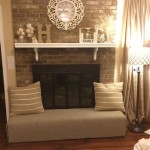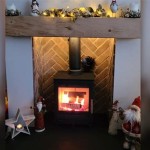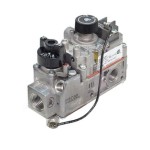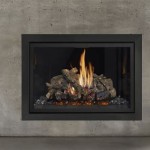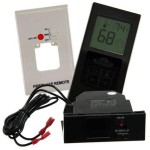TV Above Fireplace Ideas: Combining Entertainment and Ambiance
The decision to mount a television above a fireplace is a common one in modern home design. It addresses the desire to maximize space and integrate entertainment into the central living area. However, carefully considering various factors is crucial to ensure a visually appealing, comfortable, and safe setup. This article explores different approaches to achieve a harmonious blend of technology and traditional hearth, offering a comprehensive guide for implementing this design choice.
Assessing the Feasibility of Mounting a TV Above a Fireplace
Before proceeding with any installation, a thorough assessment of the fireplace and surrounding area is essential. This involves evaluating several key factors that directly impact the success and longevity of the setup. Firstly, the type of fireplace significantly influences the design approach. Gas fireplaces generally produce less heat than traditional wood-burning fireplaces, making them more suitable for mounting a television above. The heat output of a wood-burning fireplace can potentially damage the television's internal components over time, leading to malfunctions or reduced lifespan. Therefore, if a wood-burning fireplace is present, implementing a robust heat shield and ensuring adequate ventilation becomes paramount. Secondly, the wall structure behind the fireplace must be considered. Is it made of drywall, brick, stone, or another material? Each material requires different mounting hardware and techniques to ensure the television is securely fastened and can withstand the weight. Brick and stone walls often necessitate specialized drilling tools and anchors, while drywall may require reinforcing with additional supports to prevent sagging or detachment. Thirdly, the viewing angle and distance from the seating area must be carefully calculated. A television mounted too high can cause neck strain and discomfort during extended viewing sessions. The ideal viewing height is generally considered to be when the center of the screen is at eye level when seated. Proper measurements and planning are therefore crucial to optimizing the viewing experience. Finally, consider the placement of electrical outlets and cable connections. Concealing wires is essential for a clean and aesthetically pleasing look. If existing outlets are not conveniently located, hiring a qualified electrician to install new ones is recommended to avoid unsightly dangling cables.
The depth of the fireplace mantel, or the addition of a custom-built mantel, can also contribute to heat deflection and provide an additional layer of protection for the television. A deep mantel acts as a barrier, preventing direct heat from rising and impacting the back of the television. Furthermore, it provides a visual separation between the fireplace and the television, creating a more balanced and integrated aesthetic. The mantel can also serve as a shelf for decorative items or soundbars, further enhancing the functionality and style of the space.
Design Considerations for Integrating the Television and Fireplace
Beyond the technical aspects, the aesthetic integration of the television and fireplace is crucial for creating a cohesive and visually appealing living space. Color palettes, materials, and overall design style should be carefully considered to ensure a harmonious blend of technology and traditional elements. One popular approach is to use a contrasting color scheme to highlight both the fireplace and the television. For example, a dark-colored television mounted above a light-colored fireplace can create a striking visual contrast that draws the eye and adds depth to the room. Alternatively, a monochromatic color scheme can be used to create a more subtle and understated look. Painting the wall behind the fireplace and television in a single color can help to unify the two elements and create a sense of cohesiveness. The choice of materials also plays a significant role in the overall aesthetic. Wood, stone, and brick are common materials used in fireplace design, each offering a unique texture and visual appeal. The material chosen for the fireplace surround should complement the style of the television and the surrounding furniture. For example, a rustic stone fireplace might pair well with a dark-framed television and leather furniture, while a sleek modern fireplace might be better suited to a frameless television and minimalist décor.
Furthermore, consider the size and shape of both the television and the fireplace. A large television mounted above a small fireplace can appear disproportionate and overwhelming, while a small television mounted above a large fireplace can look lost and insignificant. The size of the television should be carefully chosen to complement the scale of the fireplace and the overall dimensions of the room. Similarly, the shape of the fireplace can influence the placement and orientation of the television. A horizontal fireplace might be better suited to a wide-screen television, while a vertical fireplace might be better suited to a taller, narrower television. Ultimately, the goal is to create a balanced and visually appealing composition that seamlessly integrates the television and fireplace into the overall design of the room. The surrounding décor can also enhance the integration. Flanking the fireplace with bookshelves or cabinets can create a sense of symmetry and balance, while adding decorative items such as candles, vases, or artwork can personalize the space.
Safety Measures and Heat Management Strategies
Mitigating the potential risks associated with heat exposure is paramount when placing a television above a fireplace. Heat can damage the internal components of the television, leading to premature failure or reduced performance. Implementing several strategies can effectively minimize the impact of heat and ensure the longevity of the television. Installing a heat shield is a primary defense against rising heat. A heat shield is a physical barrier that deflects heat away from the television. It can be made of various materials, such as metal, ceramic, or insulated foam, and should be strategically positioned to protect the back of the television. The size and placement of the heat shield should be carefully considered to ensure maximum effectiveness. Sufficient ventilation is also crucial for dissipating heat. Ensuring adequate airflow around the television can help to prevent heat buildup and maintain a safe operating temperature. This can be achieved by leaving sufficient space between the television and the wall, as well as ensuring that the area around the fireplace is well-ventilated. Avoid blocking any ventilation openings on the television itself, as this can restrict airflow and exacerbate heat buildup.
Monitoring the temperature behind the television is also essential for detecting potential problems early on. A simple thermometer can be placed behind the television to monitor the temperature. If the temperature consistently exceeds the manufacturer's recommended operating range, adjustments to the heat shield, ventilation, or fireplace usage may be necessary. Consider using a fireplace insert or a gas fireplace with a built-in heat deflector. Fireplace inserts are designed to minimize heat loss and direct heat more efficiently, while gas fireplaces with heat deflectors are specifically designed to reduce the amount of heat that rises towards the television. These options can be particularly effective for wood-burning fireplaces, which tend to generate more heat than gas fireplaces. Finally, regular maintenance of the fireplace is essential for ensuring its safe and efficient operation. This includes cleaning the chimney regularly to prevent creosote buildup, inspecting the fireplace for any signs of damage or wear, and ensuring that the fire is properly extinguished after each use. By implementing these safety measures and heat management strategies, the risk of heat damage to the television can be significantly reduced, ensuring a safe and enjoyable viewing experience.
Selecting the appropriate mounting hardware is equally important for ensuring the safety and stability of the television. Choose a mount that is specifically designed for mounting televisions above fireplaces and that is compatible with the size and weight of the television. The mount should be securely anchored to the wall using appropriate hardware for the wall material. Consider using a tilting mount to adjust the viewing angle as needed. This can be particularly useful if the television is mounted high above the fireplace, as it allows the screen to be angled downwards for a more comfortable viewing experience.

Debate Should Your Tv Go Over Fireplace Plus The Perfect Compromise Built Ins In Around Remodel

Stop Hanging Your Television Over Fireplace

Tv Above Fireplace Design Ideas
:max_bytes(150000):strip_icc()/CarinaSkrobeckiPhoto_22021SE32ndSt_22-70a79cdf77c44aa6959259ebfb7f9f69-62bcab6ff8c045b2929bf14461a94288.jpg?strip=all)
35 Ways To Make The Tv Over A Fireplace Look Better

20 Amazing Tv Above Fireplace Design Ideas Stone Designs Basement

Putting A Tv Above The Fireplace May Not Be Such Bad Idea After All

35 Fireplace Ideas With Tv Above For A Cozy View Nikki S Plate

Placing A Tv Over Your Fireplace Design Ideas Classic Living Room Home Family

Mantel Decorating With A Tv 10 Ideas And Tips Nina Hendrick

Contemporary Modern Fireplace Designs With Tv Above Mantel

